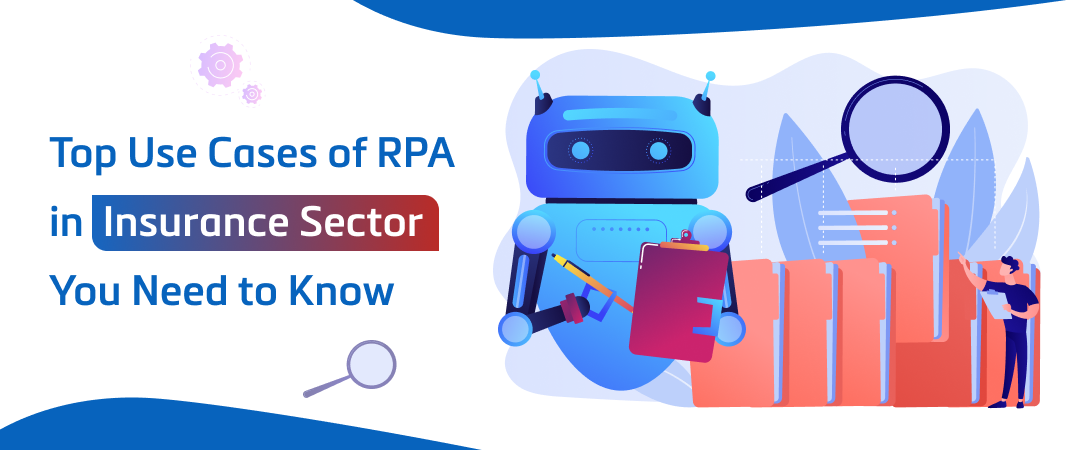
Top Use Cases of RPA in Insurance Sector You Need to Know

You know that the insurance industry is the mainstream in the global economy and totally relies on manual paperwork. Traditional methods like processing claims, managing customer relationships, human judgment for underwriting policies, and manual paperwork are followed in the insurance sector.
These practices have been followed for decades and often result in errors, delays, and inefficiencies in operational processes and customer satisfaction.
Presently, as technologies are transforming the way we act, insurance is the major sector needing to refine their operations with automation to cover the risks faced by them in their daily process.
In this blog, we will discuss the challenges faced in the traditional insurance sector, what is RPA in insurance industry, top use cases of RPA in insurance sector, their benefits, and the guidelines to implement them in the industry.
Let’s Get in Quickly!
See How RPA Works in Insurance Claim | Schedule Demo WhatsApp | Skype
Challenges in Traditional Insurance Processes
The traditional operational process in insurance sector highlights various challenges like:
Manual Data Entry: Employees spend half of their working time entering and correcting the data, which increases the labor cost and risks of mis-entry entry.
Paper-Based Workflows: Physical forms of documents are mostly exposed to misplacements, damage, or lead inefficiencies.
High Operational Costs: Manual tasks mostly are time-consuming and a slow process, also service delivery delays.
Error Prone Systems: Data processing by humans mostly ends up in errors, resulting in reputational and financial losses.
Regulatory Compliance: People must be updated with the changes in the regulations that require substantial effort and resources.
What is RPA in Insurance?
To overcome the challenges in manual operational processes in the insurance sector, Robotic Process Automation is introduced. This is a reshaping solution for the bottlenecks faced by the insurers, as it streamlines processes, scales operations, and reduces costs effectively.
Bots are used in RPA to perform repetitive and rule-based tasks which are done by humans. These bots are capable of handling various insurance functions from policy administration to customer service and claim processing.
RPA provides complete scalable and efficient results making insurers enhance their service for customers and improve workflow operations.
Also, Read: Top 20 Use case of RPA bots in Hospitality Industry
Key Use Cases of RPA in Insurance Sector
RPA in the insurance industry is used for various functions to enhance productivity in the organization and improve the work efficiency of the insurers.
Let’s unfold the Use Cases of RPA in insurance industry:
Claim Processing: The end-to-end claim processing is automated by RPA from receiving claims to verification of details and payment process. This alternatively minimizes the processing time, human errors and enhances customer satisfaction. For instance, implementing RPA in the insurance industry can save much time by automating claim corrections and data extraction tasks.
Underwriting: Collecting and analyzing customer data for assessing risk is a time-consuming process. RPA accelerates underwriting by automating data collection from various sources like social media, credit scores, and more, which in turn enables a faster and more accurate policy insurance.
Customer Service: Automation enhances customer experience by providing 24/7 support and engagement. Bots can answer all the queries by the customer that is assisted with product information and route the queries that alternatively make human agents focus on complex customer requirements.
Regulatory Compliance: Through data validation, report generation, and safe audit trail maintenance, RPA streamlines compliance with strict documentation and audit standards. Automation guarantees precision in regulatory procedures and lowers the risk of non-compliance.
Policy Administration: Tasks like policy issuance, endorsements, premium billing, cancellations, and data updates are streamlined by RPA. These processes are automated to make sure there is a high level of accuracy, compliance and to make employees focus on strategic initiatives.
Data Management: Insurers deal with vast amounts of data from various sources. Automation is made via RPA for data extraction, integration, and validation that are used for the decision-making process and maintain consistency and accuracy on the data.
Fraud Detection: Fraudulent activities in the insurance sector create a significant financial risk for the industry. RPA with AI and machine learning analyzes transaction patterns to detect and flag potential fraud cases, safeguarding companies from financial losses.
Billing and Payments: Timely and accurate invoicing, transaction processing, and payment reminders are ensured by RPA to improve cash flow and reduce errors in financial management.
Marketing, Sales, and Distribution: Tasks like market analysis, data collection, customer segmentation, and targeted communication are optimized by RPA to enable efficient go-to-market strategies.
Reinsurance Administration: Reinsurance contracts management is automated to simplify complex calculations and ensure compliance with contractual terms, optimizes risk management.
See How RPA Works in Insurance Claim | Schedule Demo WhatsApp | Skype
Benefits of RPA in Insurance Industry
- RPA bots enhance efficiency by operating 24/7, handling repetitive tasks, and increasing operational speed.
- Robotic Process Automation in insurance reduces labor costs and provides significant financial savings.
- Integrating bots offers enhanced accuracy by providing improved data quality and reduces risks related to processes by humans.
- RPA in insurance adheres to the strict industry regulations.
- Integration of RPA in the existing systems can be done seamlessly without any disrupting operations.
- Bots are quickly scaled to meet increasing workloads, enabling insurers to respond to new opportunities and demands efficiently.
- Automating queries makes agents improve customer experience surging satisfaction and loyalty.
Implementing RPA in Insurance: Guidelines
Step 1: Training the staff with the skills needed to manage RPA and other technologies like AI and ML.
Step 2: Initially start small by automating high volume, repetitive tasks to check out RPA’s viability.
Step 3: Develop a complete implementation roadmap analyzing cost benefits, success metrics, and project milestones and adopt RPA.
Also, Read: RPA Security Best Practices: A Comprehensive Guide for Organizations
Summing Up
As the blog delves into the use cases of RPA in the insurance sector, we can come to an end that RPA is a game changer to overcome all the traditional challenges and create a promising future for insurers.
By adopting RPA, insurers can provide top-notch customer experience, reduce costs, and future-proof their operations. As the industry grows, you will come to know that RPA is no longer an option but a necessary one for businesses looking for sustainable growth.
Still having a question on the operational process of RPA for your insurance company, don’t wait, contact iSQUARE now for Robotic Process Automation Services.
We make innovative custom-based services for your organization. Our professionals are skilled and have successfully developed various automation projects in different industries.
Why wait, contact us for your business needs.
See How RPA Works in Insurance Claim | Schedule Demo WhatsApp | Skype














